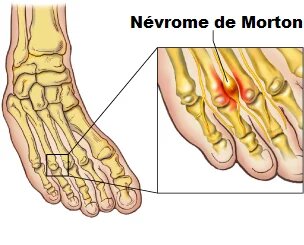Morton's neuroma
Morton's neuroma
 Morton's Neuroma is a swelling of the scar tissue around the nerves of the toes that causes sharp pain, usually between the 3rd and 4th toe. The burning-like pain is felt when standing or walking and rarely in both feet at once.
Morton's Neuroma is a swelling of the scar tissue around the nerves of the toes that causes sharp pain, usually between the 3rd and 4th toe. The burning-like pain is felt when standing or walking and rarely in both feet at once.
Causes
The exact cause of Morton's neuroma is not well known, but it could be the consequence of a compression of the forefoot nerve due to shoes that are too narrow. It could also be caused by thickening and scarring of the tissue around the nerves that communicate with the toes in response to irritation, pressure, or injury. More rarely, Morton's neuroma develops between the 2nd and 3rd toe. In about 1 in 5 patients, the neuroma appears in both feet. Morton's neuroma is a common foot ailment and is thought to be more common in women, possibly due to the more frequent wearing of high-heeled or narrow shoes.
Diagnosis
A medical examination is usually sufficient to establish the diagnosis of Morton's neuroma. MRI (magnetic resonance imaging) is rarely useful for confirming a diagnosis, it is expensive and can be falsely positive in a third of cases who are asymptomatic.
Intervention
The intervention can be performed in outpatient surgery or in conventional hospitalization, depending on the case. It can be done under general anesthesia, or locoregional anesthesia. It takes place in the operating room under strictly aseptic conditions. The surgeon and the theater team place you in a supine position on the operating table. After the usual skin preparation in the operating room, the sterile drapes are placed. The procedure consists of excising the neuroma responsible for the pain through a small incision made in the interdigital space concerned.
Operative suites
Most of the intervention is performed on an outpatient basis, the patient can walk as soon as the anesthesia. Symptoms disappear immediately.
Risks and complications
Hematoma.
Infection.
Algodystrophy.